Title search results
Showing 1 - 19 of 19 items

A masterful telling of the way World War Two has been remembered, forgotten, and remade by Canada over seventy-five years.…
The Second World War shaped modern Canada. It led to the country's emergence as a middle power on the world stage; the rise of the welfare state; industrialization, urbanization, and population growth. After the war, Canada increasingly turned toward the United States in matters of trade, security, and popular culture, which then sparked a desire to strengthen Canadian nationalism from the threat of American hegemony. The Fight for History examines how Canadians framed and reframed the war experience over time. Just as the importance of the battle of Vimy Ridge to Canadians rose, fell, and rose again over a 100-year period, the meaning of Canada's Second World War followed a similar pattern. But the Second World War's relevance to Canada led to conflict between veterans and others in society—more so than in the previous war—as well as a more rapid diminishment of its significance. By the end of the 20th century, Canada's experiences in the war were largely framed as a series of disasters. Canadians seemed to want to talk only of the defeats at Hong Kong and Dieppe or the racially driven policy of the forced relocation of Japanese-Canadians. In the history books and media, there was little discussion of Canada's crucial role in the Battle of the Atlantic, the success of its armies in Italy and other parts of Europe, or the massive contribution of war materials made on the home front. No other victorious nation underwent this bizarre reframing of the war, remaking victories into defeats. The Fight for History is about the efforts to restore a more balanced portrait of Canada's contribution in the global conflict. This is the story of how Canada has talked about the war in the past, how we tried to bury it, and how it was restored. This is the history of a constellation of changing ideas, with many historical twists and turns, and a series of fascinating actors and events
The Secret History of Soldiers: How Canadians Survived the Great War
By Tim Cook. 2018
There have been thousands of books on the Great War, but most have focused on commanders, battles, strategy, and tactics.…
Less attention has been paid to the daily lives of the combatants, how they endured the unimaginable conditions of industrial warfare: the rain of shells, bullets, and chemical agents. In The Secret History of Soldiers, Tim Cook, Canada's foremost military historian, examines how those who survived trench warfare on the Western Front found entertainment, solace, relief, and distraction from the relentless slaughter. These tales come from the soldiers themselves, mined from the letters, diaries, memoirs, and oral accounts of more than five hundred combatants. Rare examples of trench art, postcards, and even song sheets offer insight into a hidden society that was often irreverent, raunchy, and anti-authoritarian. Believing in supernatural stories was another way soldiers shielded themselves from the horror. While novels and poetry often depict the soldiers of the Great War as mere victims, this new history shows how the soldiers pushed back against the grim war, refusing to be broken in the mincing machine of the Western Front. The violence of war is always present, but Cook reveals the gallows humour the soldiers employed to get through it. Over the years, both writers and historians have overlooked this aspect of the men's lives. The fighting at the front was devastating, but behind the battle lines, another layer of life existed, one that included songs, skits, art, and soldier-produced newspapers.With his trademark narrative abilities and an unerring eye for the telling human detail, Cook has created another landmark history of Canadian military life as he reveals the secrets of how soldiers survived the carnage of the Western Front.
Warlords: Borden, Mackenzie King and Canada's world wars
By Tim Cook. 2012
Two portraits flank the doors leading into Canada’s House of Commons: Sir Robert Borden to the left and W.L.M. King…
to the right. While each man appears flatteringly stern, wise, and charismatic, it is the portrait plaques that are of particular interest: Borden's caption reads: “World War I War Leader, 1914–1918,” while King’s caption is similar: “World War II War Leader, 1939–1945.” No other dates are given. Perhaps that definition makes sense for Borden, who did little of note before the war; it does not ring true for King, Canada’s longest serving prime minister. Yet in both cases, world wars shaped their careers and legacies. 2012.
At the sharp end: Canadians fighting the Great War, 1914-1916
By Tim Cook. 2007
Covers the harrowing early battles of World War One, when tens of thousands, then hundreds of thousands, died, before the…
generals and soldiers found ways to break the terrible stalemate of the front. It provides both an intimate look at the Canadian men in the trenches and an authoritative account of the slow evolution in tactics, weapons, and advancement. A recounting of the Great War through soldiers' eyewitness accounts. Explicit descriptions of violence, strong language. 2007.
Follows the Canadian fighting forces during the battles of Vimy Ridge, Hill 70, Passchendaele, and the Hundred Days campaign, through…
the eyes of the soldiers who fought and died in the trenches, and based on newly uncovered sources. The Canadian fighting forces never lost a battle during the final 2 years of the war, and although they paid a terrible price, they were indeed, as British Prime Minister David Lloyd George exclaimed, the shock troops of the Empire. Companion to "At the sharp end" (DC32639). Some descriptions of sex and descriptions of violence. 2009.
Vimy: the battle and the legend
By Tim Cook. 2017
Cook examines the battle of Vimy Ridge in April 1917 and the way the memory of it has evolved over…
100 years. Vimy is unlike any other battle in Canadian history: it has been described as the "birth of the nation." But the meaning of that phrase has never been explored, nor has any writer explained why the battle continues to resonate with Canadians. The Vimy battle that began April 9, 1917, was the first time the four divisions of the Canadian Expeditionary Force fought together. 10,600 men were killed or injured over four days--twice the casualty rate of the Dieppe Raid in August 1942. Bestseller. 2017.
Sir Sam Hughes - Minister of Militia and Defence from 1911 until his dismissal in 1916 - is remembered as…
abrasive and unstable, while Sir Arthur Currie, a part-time soldier who rose to command the Canadian Corps in France and Belgium, is remembered as one of the most effective generals of the war and a national hero. But initially, Hughes drove the nation toward a war footing and fought to keep Canadian troops from being parceled out to the British, while Currie embezzled regimental funds, never connected with his soldiers, and was accused of wantonly squandering the lives of 60,000 Canadians on the road to victory. c2010.This book shows in impressive detail how soldiers, airmen, and sailors fought - the evolving tactics, weapons of war, logistics,…
and technology. It gauges Canadian effectiveness against the skilled enemy whom they confronted in battlefields from 1939 to 1943, from the sweltering heat of Sicily to the frigid North Atlantic, and from the urban warfare of Ortona to the dark skies over Germany. "The Necessary War" examines the equally important factors of morale, discipline, and fortitude of the Canadian citizen-soldiers. 2014.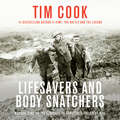
From Canada’s top war historian, a definitive medical history of the Great War, illuminating how the carnage of modern battle…
gave birth to revolutionary life-saving innovations. It brings to light shocking revelations of the ways the brutality of combat and the necessity of agonizing battlefield decisions led to unimaginable strain for men and women of medicine who fought to save the lives of soldiers.Medical care in almost all armies, and especially in the Canadian medical services, was sophisticated and constantly evolving, with vastly more wounded soldiers saved than lost. Doctors and surgeons prevented disease from decimating armies, confronted ghastly wounds from chemical weapons, remade shattered bodies, and struggled to ease soldiers’ battle-haunted minds. After the war, the hard lessons learned by doctors and nurses were brought back to Canada. A new Department of Health created guidelines in the aftermath of the 1918-19 flu pandemic, which had killed 55,000 Canadians and millions around the world. In a grim irony, the fight to improve civilian health was furthered by the most destructive war up to that point in human history. But medical advances were not the only thing brought back from Europe: Lifesavers and Body Snatchers exposes the disturbing story of the harvesting of human body parts in medical units behind the lines. Tim Cook has spent over a decade investigating the history of Canadian medical doctors removing the body parts of slain Canadian soldiers and transporting their brains, lungs, bones, and other organs to the Royal College of Surgeons (RCS) in London, England. Almost 800 individual body parts were removed from dead soldiers and sent to London, where they were stored, treated, and some presented in exhibition galleries. After being exhibited there, the body parts were displayed in Canada. This uncovered history is a shockingly revelation never told before and part of the hidden legacy of the medical war. Based on deep archival research and unpublished letters of soldiers and medical personnel, Lifesavers and Body Snatchers is a powerful narrative, told in Cook’s literary style, which reveals how the medical services supported the soldiers at the front and forged a profound legacy in shaping Canadian public health in the decades that followed.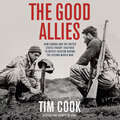
From our country's most important war historian, a gripping account of the turbulent relationship between Canada and the US during…
the Second World War. The two nations entered the war amidst rivalry and mutual suspicion, but learned to fight together before emerging triumphant and bound by an alliance that has lasted to this day.When the Second World War broke out in 1939, it set in motion a deadly struggle between the Axis powers and the Allies, but also fraught negotiations between and among the Allies. On questions of diplomacy, economic policy, industrial might, military capabilities, and even national sovereignty, thousands of lives and the fate of the free world depended on back-room deals and desperate trade-offs between soldiers, diplomats, and leaders.In North America, Canada and the US strained to forge a new military alliance to guard their coasts and fend off German U-boats and the menace of a Japanese invasion. Wartime economies were entwined to produce a staggering contribution of weapons to keep Britain and other allies in the war. The defense of North America against enemy threats was essential before the US and Canada could send armies, navies, and air forces overseas.In his trademark style, Tim Cook employs eyewitness accounts to vividly lay bare the brutality of combat and the courage of North Americans under fire. Behind the fighting fronts, the charged and often secret communications between national leaders Churchill, Roosevelt, and King reveals how their personalities shaped the outcome of history’s most destructive war, the fate of the British Empire, and the North American alliance that lives on to this day.The Good Allies is a masterful account of how Canadians and Americans made the transition from wary rivals to steadfast allies, and how Canada thrived in the shadow of the military and global superpower. In exploring this complex and crucial dimension of the Second World War and its legacy, Cook recounts two nations’ story of cooperation, of sacrifice, and of bleeding together to save the world from the fascist threat.
A masterful telling of the way World War Two has been remembered, forgotten, and remade by Canada over seventy-five years.…
The Second World War shaped modern Canada. It led to the country's emergence as a middle power on the world stage; the rise of the welfare state; industrialization, urbanization, and population growth. After the war, Canada increasingly turned toward the United States in matters of trade, security, and popular culture, which then sparked a desire to strengthen Canadian nationalism from the threat of American hegemony. The Fight for History examines how Canadians framed and reframed the war experience over time. Just as the importance of the battle of Vimy Ridge to Canadians rose, fell, and rose again over a 100-year period, the meaning of Canada's Second World War followed a similar pattern. But the Second World War's relevance to Canada led to conflict between veterans and others in society--more so than in the previous war--as well as a more rapid diminishment of its significance. By the end of the 20th century, Canada's experiences in the war were largely framed as a series of disasters. Canadians seemed to want to talk only of the defeats at Hong Kong and Dieppe or the racially driven policy of the forced relocation of Japanese-Canadians. In the history books and media, there was little discussion of Canada's crucial role in the Battle of the Atlantic, the success of its armies in Italy and other parts of Europe, or the massive contribution of war materials made on the home front. No other victorious nation underwent this bizarre reframing of the war, remaking victories into defeats. The Fight for History is about the efforts to restore a more balanced portrait of Canada's contribution in the global conflict. This is the story of how Canada has talked about the war in the past, how we tried to bury it, and how it was restored. This is the history of a constellation of changing ideas, with many historical twists and turns, and a series of fascinating actors and events.
Snowy to the Somme: A Muddy and Bloody Campaign, 1916-1918
By Tim Cook. 2014
In 1915, news of the Australian and New Zealand Army Corps landing and the slaughter at Gallipoli stirred tens of…
thousands of young men to go to war. They answered the call and formed battalions of the Australian Imperial Force. By the time the new recruits were combat ready, the campaign at Gallipoli had ended. Their battlefields became the muddy paddocks of France and Belgium. Based on eyewitness accounts, Snowy to the Somme traces the story of one of these battalions, the 55th, from its birth in the dusty camps of Egypt through three years of brutal, bloody conflict on the bitter Western Front. When the Great War ended in 1918, over 500 of the 3,000 men who served in the 55th had been slain and another 1,000 wounded. Snowy to the Somme, shares personal stories of Australian men as they stared down the horrors of war with determination, courage and mateship. With chapters devoted to the significant battles at Fromelles, Doignies, Polygon Wood, Péronne and Bellicourt, this book tells the story of one battalion, but in doing so it encapsulates the experiences of many Australians on the Western Front.
The Secret History of Soldiers: How Canadians Survived the Great War
By Tim Cook. 2018
There have been thousands of books on the Great War, but most have focused on commanders, battles, strategy, and tactics.…
Less attention has been paid to the daily lives of the combatants, how they endured the unimaginable conditions of industrial warfare: the rain of shells, bullets, and chemical agents. In The Secret History of Soldiers, Tim Cook, Canada's foremost military historian, examines how those who survived trench warfare on the Western Front found entertainment, solace, relief, and distraction from the relentless slaughter. These tales come from the soldiers themselves, mined from the letters, diaries, memoirs, and oral accounts of more than five hundred combatants. Rare examples of trench art, postcards, and even song sheets offer insight into a hidden society that was often irreverent, raunchy, and anti-authoritarian. Believing in supernatural stories was another way soldiers shielded themselves from the horror. While novels and poetry often depict the soldiers of the Great War as mere victims, this new history shows how the soldiers pushed back against the grim war, refusing to be broken in the mincing machine of the Western Front. The violence of war is always present, but Cook reveals the gallows humour the soldiers employed to get through it. Over the years, both writers and historians have overlooked this aspect of the men's lives. The fighting at the front was devastating, but behind the battle lines, another layer of life existed, one that included songs, skits, art, and soldier-produced newspapers.With his trademark narrative abilities and an unerring eye for the telling human detail, Cook has created another landmark history of Canadian military life as he reveals the secrets of how soldiers survived the carnage of the Western Front.
Vimy: The Battle and the Legend
By Tim Cook. 2017
A bold new telling of the defining battle of the Great War, and how it came to signify and solidify…
Canada’s national identityWhy does Vimy matter? How did a four-day battle at the midpoint of the Great War, a clash that had little strategic impact on the larger Allied war effort, become elevated to a national symbol of Canadian identity? Tim Cook, Canada’s foremost military historian and a Charles Taylor Prize winner, examines the Battle of Vimy Ridge and the way the memory of it has evolved over 100 years. The operation that began April 9, 1917, was the first time the four divisions of the Canadian Corps fought together. More than 10,000 Canadian soldiers were killed or injured over four days—twice the casualty rate of the Dieppe Raid in August 1942. The Corps’ victory solidified its reputation among allies and opponents as an elite fighting force. In the wars’ aftermath, Vimy was chosen as the site for the country’s strikingly beautiful monument to mark Canadian sacrifice and service. Over time, the legend of Vimy took on new meaning, with some calling it the “birth of the nation.” The remarkable story of Vimy is a layered skein of facts, myths, wishful thinking, and conflicting narratives. Award-winning writer Tim Cook explores why the battle continues to resonate with Canadians a century later. He has uncovered fresh material and photographs from official archives and private collections across Canada and from around the world. On the 100th anniversary of the event, and as Canada celebrates 150 years as a country, Vimy is a fitting tribute to those who fought the country’s defining battle. It is also a stirring account of Canadian identity and memory, told by a masterful storyteller.
Fight to the Finish
By Tim Cook. 2015
The magisterial second volume of Tim Cook's definitive account of Canadians fighting in the Second World War. Historian Tim Cook…
displays his trademark storytelling ability in the second volume of his masterful account of Canadians in World War II. Cook combines an extraordinary grasp of military strategy with a deep empathy for the soldiers on the ground, at sea and in the air. Whether it's a minute-by-minute account of a gruelling artillery battle, vicious infighting among generals, the scene inside a medical unit, or the small details of a soldier's daily life, Cook creates a compelling narrative. He recounts in mesmerizing detail how the Canadian forces figured in the Allied bombing of Germany, the D-Day landing at Juno beach, the taking of Caen, and the drive south. Featuring dozens of black-and-white photographs and moving excerpts from letters and diaries of servicemen, Fight to the Finish is a memorable account of Canadians who fought abroad and of the home front that was changed forever.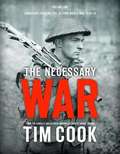
The Necessary War Volume 1
By Tim Cook. 2014
Tim Cook, Canada's leading war historian, ventures deep into World War Two in this epic two-volume story of heroism and…
horror, of loss and longing, sacrifice and endurance. Written in Cook's compelling narrative style, this book shows in impressive detail how soldiers, airmen, and sailors fought--the evolving tactics, weapons of war, logistics, and technology. It gauges Canadian effectiveness against the skilled enemy whom they confronted in battlefields from 1939 to 1943, from the sweltering heat of Sicily to the frigid North Atlantic, and from the urban warfare of Ortona to the dark skies over Germany. The Necessary War examines the equally important factors of morale, discipline, and fortitude of the Canadian citizen-soldiers. The war was an engine of transformation for Canada. With a population of fewer than twelve million, Canada embraced its role as an arsenal of democracy, exporting war supplies, feeding its allies, and raising a million-strong armed forces that served and fought in nearly every theatre of war. The nation was mobilized like never before in the fight to preserve the liberal democratic order. The six-year-long exertion caused disruption, provoked nationwide industrialization, ushered in changes to gender roles, exacerbated the tension between English and French, and forged a new sense of Canadian identity. Canadians were willing to bear almost any burden and to pay the ultimate price in the pursuit of victory. As with his award-winning two-volume series on WWI, Tim Cook uses original sources, letters from soldiers, rare documents, and maps of battlefields to illustrate the contributions and sacrifices made by what is often called the greatest generation. Magisterial in its scope, The Necessary War illuminates Canada's past as never before. From the Western Front to the home front, Canadians served many roles in a war that had to be fought and won.
From Canada&’s top war historian, a definitive medical history of the Great War, illuminating how the carnage of modern battle…
gave birth to revolutionary life-saving innovations. It brings to light shocking revelations of the ways the brutality of combat and the necessity of agonizing battlefield decisions led to unimaginable strain for men and women of medicine who fought to save the lives of soldiers.Medical care in almost all armies, and especially in the Canadian medical services, was sophisticated and constantly evolving, with vastly more wounded soldiers saved than lost. Doctors and surgeons prevented disease from decimating armies, confronted ghastly wounds from chemical weapons, remade shattered bodies, and struggled to ease soldiers&’ battle-haunted minds. After the war, the hard lessons learned by doctors and nurses were brought back to Canada. A new Department of Health created guidelines in the aftermath of the 1918-19 flu pandemic, which had killed 55,000 Canadians and millions around the world. In a grim irony, the fight to improve civilian health was furthered by the most destructive war up to that point in human history. But medical advances were not the only thing brought back from Europe: Lifesavers and Body Snatchers exposes the disturbing story of the harvesting of human body parts in medical units behind the lines. Tim Cook has spent over a decade investigating the history of Canadian medical doctors removing the body parts of slain Canadian soldiers and transporting their brains, lungs, bones, and other organs to the Royal College of Surgeons (RCS) in London, England. Almost 800 individual body parts were removed from dead soldiers and sent to London, where they were stored, treated, and some presented in exhibition galleries. After being exhibited there, the body parts were displayed in Canada. This uncovered history is a shockingly revelation never told before and part of the hidden legacy of the medical war. Based on deep archival research and unpublished letters of soldiers and medical personnel, Lifesavers and Body Snatchers is a powerful narrative, told in Cook&’s literary style, which reveals how the medical services supported the soldiers at the front and forged a profound legacy in shaping Canadian public health in the decades that followed.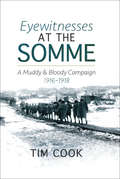
Eyewitnesses at the Somme: A Muddy and Bloody Campaign, 1916–1918
By Tim Cook. 2017
In 1915, news of the Australian and New Zealand Army Corps landing and the slaughter at Gallipoli stirred tens of…
thousands of young men to go to war.They answered the call and formed battalions of the Australian Imperial Force. By the time the new recruits were combat ready, the campaign at Gallipoli had ended. Their battlefields became the muddy paddocks of France and Belgium.Based on eyewitness account, Eyewitnesses at the Somme traces the story of one of these battalions, the 55th, from its birth in the dusty camps of Egypt through three years of brutal, bloody conflict on the bitter western front.When the Great War ended in 1918, over 500 of the 3,000 men who served in the 55th had been slain and another 1,000 wounded. Eyewitnesses at the Somme, shares personal stories of Australian men as they stared down the horrors of war with determination, courage and comradeship. With chapters devoted to the significant battles at Fromelles, Doignies, Polygon Wood, Pronne and Bellicourt, this book tells the story of one battalion, but in doing so it encapsulates the experiences of many Australians on the Western Front.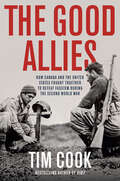
From our country's most important war historian, a gripping account of the turbulent relationship between Canada and the US during…
the Second World War. The two nations entered the war amidst rivalry and mutual suspicion, but learned to fight together before emerging triumphant and bound by an alliance that has lasted to this day.When the Second World War broke out in 1939, it set in motion a deadly struggle between the Axis powers and the Allies, but also fraught negotiations between and among the Allies. On questions of diplomacy, economic policy, industrial might, military capabilities, and even national sovereignty, thousands of lives and the fate of the free world depended on back-room deals and desperate trade-offs between soldiers, diplomats, and leaders.In North America, Canada and the US strained to forge a new military alliance to guard their coasts and fend off German U-boats and the menace of a Japanese invasion. Wartime economies were entwined to produce a staggering contribution of weapons to keep Britain and other allies in the war. The defence of North America against enemy threats was essential before the US and Canada could send armies, navies, and air forces overseas.In his trademark style, Tim Cook employs eyewitness accounts to vividly lay bare the brutality of combat and the courage of North Americans under fire. Behind the fighting fronts, the charged and often secret communications between national leaders Churchill, Roosevelt, and King reveal how their personalities shaped the outcome of history&’s most destructive war, the fate of the British Empire, and the North American alliance that lives on to this day.The Good Allies is a masterful account of how Canadians and Americans made the transition from wary rivals to steadfast allies, and how Canada thrived in the shadow of the military and global superpower. In exploring this complex and crucial dimension of the Second World War and its legacy, Cook recounts two nations&’ story of cooperation, of sacrifice, and of bleeding together to save the world from the fascist threat.